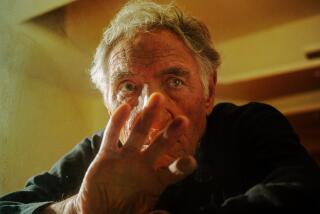His job outlook is up in the air
As a man who spends a large portion of his time in airplanes, helicopters and hot-air balloons, 48-year-old aerial director of photography John Marzano has occasionally seen his life flash before his eyes.
“There was one time on a film called ‘Air America,’ ” recalls Marzano, one of the two directors of photography who work at U.K.-based Flying Pictures. “We were filming in Thailand, and we’d been told by the local authorities that we must not fly over this one particular [sacred] mountain. And as we flew over the edge of this mountain, the helicopter suddenly had some kind of engine problem. We managed to recover the aircraft at about 3,000 feet, having dropped about 9,000 feet over the jungle. [We] nursed the aircraft back to Chiang Mai and landed on the threshold of the runway and were promptly surrounded by fire engines and ambulances.”
It was a love of photography, not flying, that led Marzano to this dramatic and dangerous line of work. Born in Kenya and raised in South Wales and England, he began failing his exams at boarding school because he was spending all his time in the darkroom. By age 18, he was itching to get into the film business, but his uncle, a commercial director, persuaded Marzano to attend college by promising him a job as a runner upon graduation.
While climbing up through the ranks of the camera department, Marzano met Marc Wolff, a film pilot with whom he still works today, and landed his first aerial job as a camera assistant. Since then, he has amassed an impressive list of credits that includes “Black Hawk Down,” “Harry Potter and the Prisoner of Azkaban,” “Casino Royale” and “Charlie Wilson’s War.” Recently, he worked as aerial director of photography on the thriller “Doomsday,” which hits theaters Friday.
Sky captains: For Marzano, the most important part of his job is creating a rapport with his pilot. “You are so dependent on the pilot putting you in the right place at the right time to get the shot,” he says. “Your camera position is not just moving linearly along a track, it’s also moving up and down, left to right, side to side. You know, if you’re flying two feet off the stern of a power boat that’s racing up a river, you’ve got to be completely trusting in the ability of your pilot not to stuff it into the back of the boat!”
The realm of the possible: Marzano doesn’t have a license, but he has learned how to fly over the years. “In the outset, it was purely as absolute fun,” he says. “We’d be flying from the helicopter base to the location, and the pilot would very kindly leave the dual controls in the copilot’s position for me, and he’d let me have a go. But I have to say it has helped me to understand some of the limitations that the pilot has to work within in terms of aerodynamics, performance and power availability. Having an understanding of what the helicopter can do has helped me immensely to create shots that are interesting and dynamic within the safety parameters of the envelope of the aircraft.”
Gloom and doom: On the Scotland set of “Doomsday,” Marzano found himself filming several so-called aerial shots from the ground. “It was a very wet and moody, miserable day,” he recalls. “Trying to shoot in among the clouds and the torrential downpours was quite spectacular. As soon as you started flying, you ended up with water on the glass, and you couldn’t shoot through that. Funnily enough, we ended up with the helicopter landed on a hilltop using the Wescam camera system basically as a tripod, because it was quicker for us to move the helicopter ‘round the mountainside, wipe the rain off the lens and then shoot with it on the ground. We carried on shooting static shots until the rain stopped, and then we’d take off and do a tracking shot or a moving shot around the actors as they trekked across the hillsides.”
Which way is up: Marzano prizes his strong stomach. “On ’28 Weeks Later,’ the director got quite sick and ended up having to stay on the ground while we went off and carried on shooting,” he says. “What tends to bring it on is if you’ve got your head down looking at the monitor and you lose your spatial awareness. And quite often I’ll say to a director, ‘If you do start to feel queasy, stop looking at the monitor straightaway, put your head up and look out at the horizon and let your brain get a fix on what’s up and what’s down and what’s vertical.’ Sometimes it helps, and sometimes it doesn’t.”
More to Read
Sign up for The Wild
We’ll help you find the best places to hike, bike and run, as well as the perfect silent spots for meditation and yoga.
You may occasionally receive promotional content from the Los Angeles Times.






